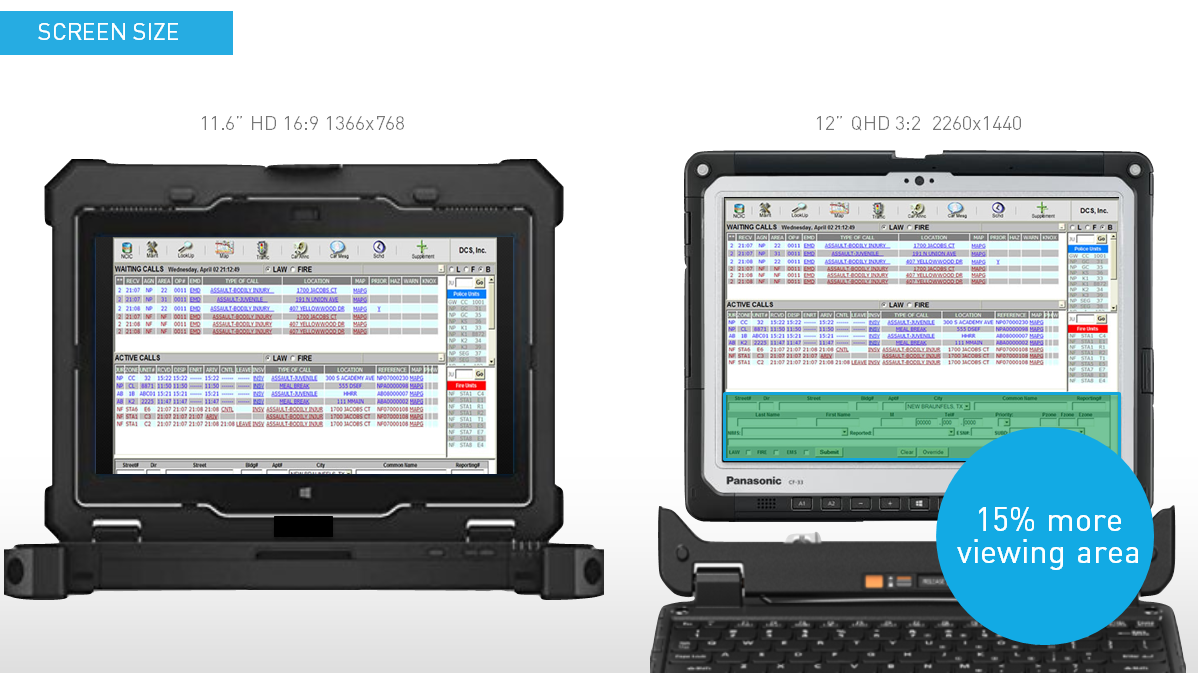Top 3 Reasons to Choose 3:2 Display for Rugged Mobile Devices
When investigating how best to outfit your organization with new mobile technology and ensure that you have the right devices to support your deskless workers, seemingly small or mundane features and specs can often create significant cost savings and improve efficiencies. By jumping in the passenger seat with our customers for ride-alongs, we’ve seen first-hand how they use technology and what environmental or physical obstacles may interfere with their workflow.
For a growing segment of our Toughbook® customers, from utility crews to police officers, we’ve found that the standard 16:9 aspect ratio doesn’t always cut it. That’s the reason we took a fresh eye to designing the screen of our new Toughbook 33 2-in-1 detachable laptop. From improved accessibility to increased efficiency, here are three reasons why employers should consider jettising the standard 16:9 display for a 3:2 display, for workers in industries such as public safety, utilities and construction.
1. Increased Productivity
While widescreen has become popular in the consumer arena, it’s best suited for viewing video or doing work at a desk. On the contrary, mobile professionals such as EMS, utility crews or repair technicians are likely to use their laptop in a vehicle, on-foot or at a job site to access feature-rich software applications. With more vertical space on the screen, 3:2 displays more information to the worker without requiring them to scroll down as frequently.
It’s important to consider the real world implications of this workflow. For example, a more efficient use of screen real estate is especially critical for fire and EMS workers – the more information they can view at a glance, the better equipped they are as they arrive on site to handle an emergency. When time is of the essence and space is limited, being able to see even a few more lines of information on screen can be invaluable and lead to higher rates of productivity while on the job. Alternatively a high resolution 3:2 display also gives users choice of lowering the default resolution to make text and icons appear larger, making it easier for users to read and interact with their display which some people may prefer instead of showing more fields. In addition, while a 11.6” widescreen and 12.0” 3:2 display may sound very close in size, the 12.0” 3:2 display is a 15% larger display. And that does not take into account that some software applications will render larger on a 3:2 design vs a 16:9 one. For mobile workers accessing data in vehicles, like firefighters, larger buttons are a welcomed improvement in the field.
2. Protected Legacy IT Investments
A 3:2 aspect ratio also helps departments save costs and protect their legacy IT systems by allowing them to modernize their mobile technology with newer, faster devices that work well with existing software applications. This capability is even more valuable for organizations or agencies with limited budgets. For example, in the public sector, many CAD (Computer Aided Dispatch) systems currently in use were originally built for older 4:3. If an agency opted for a 16:9 mobile device, the software would get distorted, compromising the user’s experience and forcing an investment in a software upgrade as well. A 3:2 display offers a solution for departments that depend on legacy software: it ensures they can extend the use of their existing systems while getting the benefits of a modern, mobile device.
The Santa Barbara Fire Department had the opportunity to test the Panasonic Toughbook 33 and saw immediate benefits of the 3:2 design over other 16:9 alternatives.
“Not only is the screen bigger and sharper so our guys can clearly read data and use the device without using the stylus in the cab, our CAD application fits perfectly and no longer is warped due to prior screen restrictions,” said Andre Monostori, IT manager for the Santa Barbara Fire Department. “If we were to design a device to fit our needs, this is exactly what we would ask for and we can’t wait to get the Toughbook 33 deployed across our department.”
3. Improved Ergonomics
Beyond the screen itself, changing the aspect ratio allows mobile professionals on-foot or on a job site to easily balance a 2-in-1 convertible device when detached and in its tablet mode. The weight of the 3:2 screen is concentrated closer to its center of mass, making it easier for workers to balance a 12” device in one hand, reducing the chance that they might drop it. This is a critical safety feature for certain users like law enforcement, since the better balance of a 3:2 prevents officers having to focus too much attention to holding the device at a critical moment when their attention is needed elsewhere. Last, widescreens are more likely to interfere with airbag zones putting occupants at risk.
For organizations looking to maximize the value they get from new mobile technology investments, a device like Panasonic Toughbook® 33 can help them discover new efficiencies and ensure workers are well equipped for the task at hand. This fully-rugged 2-in-1 detachable laptop is the first rugged mobile device with a 3:2 display. While this might seem like a small change, upon a closer look, it reveals itself to be a significant improvement for the way that the kinds of workers who rely on mobile devices perform in the field. By taking the time to rethink one detail – the size and shape of the screen – we were able to solve for so many challenges that might otherwise be overlooked.
Please visit Toughbook 33 online to learn how the world’s first fully rugged 2-in-1 detachable laptop can better equip your mobile workers.
![]()

